SURF目标识别
- 格式:pdf
- 大小:800.17 KB
- 文档页数:15
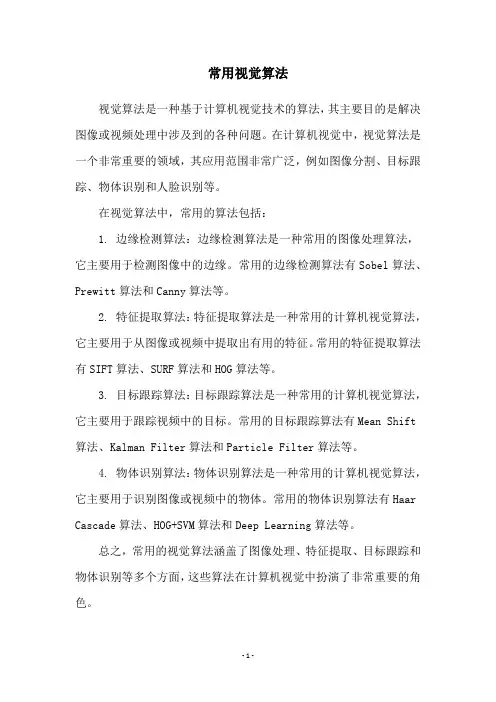
常用视觉算法
视觉算法是一种基于计算机视觉技术的算法,其主要目的是解决图像或视频处理中涉及到的各种问题。
在计算机视觉中,视觉算法是一个非常重要的领域,其应用范围非常广泛,例如图像分割、目标跟踪、物体识别和人脸识别等。
在视觉算法中,常用的算法包括:
1. 边缘检测算法:边缘检测算法是一种常用的图像处理算法,它主要用于检测图像中的边缘。
常用的边缘检测算法有Sobel算法、Prewitt算法和Canny算法等。
2. 特征提取算法:特征提取算法是一种常用的计算机视觉算法,它主要用于从图像或视频中提取出有用的特征。
常用的特征提取算法有SIFT算法、SURF算法和HOG算法等。
3. 目标跟踪算法:目标跟踪算法是一种常用的计算机视觉算法,它主要用于跟踪视频中的目标。
常用的目标跟踪算法有Mean Shift 算法、Kalman Filter算法和Particle Filter算法等。
4. 物体识别算法:物体识别算法是一种常用的计算机视觉算法,它主要用于识别图像或视频中的物体。
常用的物体识别算法有Haar Cascade算法、HOG+SVM算法和Deep Learning算法等。
总之,常用的视觉算法涵盖了图像处理、特征提取、目标跟踪和物体识别等多个方面,这些算法在计算机视觉中扮演了非常重要的角色。
- 1 -。
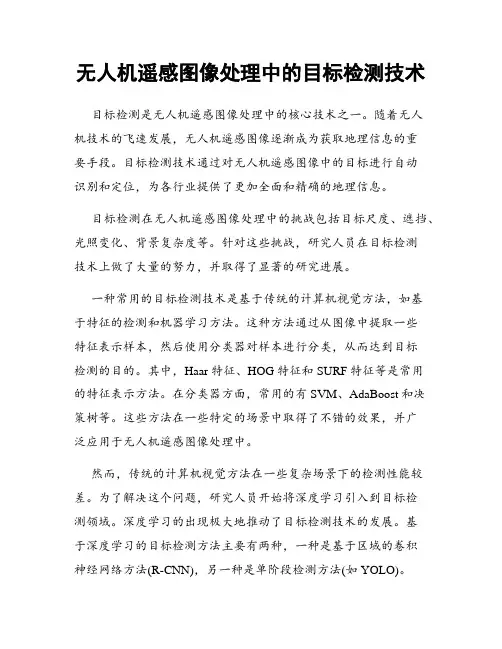
无人机遥感图像处理中的目标检测技术目标检测是无人机遥感图像处理中的核心技术之一。
随着无人机技术的飞速发展,无人机遥感图像逐渐成为获取地理信息的重要手段。
目标检测技术通过对无人机遥感图像中的目标进行自动识别和定位,为各行业提供了更加全面和精确的地理信息。
目标检测在无人机遥感图像处理中的挑战包括目标尺度、遮挡、光照变化、背景复杂度等。
针对这些挑战,研究人员在目标检测技术上做了大量的努力,并取得了显著的研究进展。
一种常用的目标检测技术是基于传统的计算机视觉方法,如基于特征的检测和机器学习方法。
这种方法通过从图像中提取一些特征表示样本,然后使用分类器对样本进行分类,从而达到目标检测的目的。
其中,Haar特征、HOG特征和SURF特征等是常用的特征表示方法。
在分类器方面,常用的有SVM、AdaBoost和决策树等。
这些方法在一些特定的场景中取得了不错的效果,并广泛应用于无人机遥感图像处理中。
然而,传统的计算机视觉方法在一些复杂场景下的检测性能较差。
为了解决这个问题,研究人员开始将深度学习引入到目标检测领域。
深度学习的出现极大地推动了目标检测技术的发展。
基于深度学习的目标检测方法主要有两种,一种是基于区域的卷积神经网络方法(R-CNN),另一种是单阶段检测方法(如YOLO)。
基于区域的卷积神经网络方法将目标检测任务分为两个阶段:生成候选区域和对候选区域进行分类。
它通过提取图像中候选区域的特征,并使用分类器对这些候选区域进行分类。
R-CNN方法的优点是能够检测出较为准确的目标位置,但缺点是处理速度较慢。
为了改善速度,研究人员提出了Fast R-CNN和Faster R-CNN等方法,大大提升了目标检测的速度。
单阶段检测方法则直接通过网络输出目标的类别和位置信息,不需要生成候选区域。
这种方法的优点是速度快,适用于实时性要求较高的应用场景。
YOLO方法是其中的代表,它通过将整个图像分成网格,每个网格预测出相应的目标类别和位置。
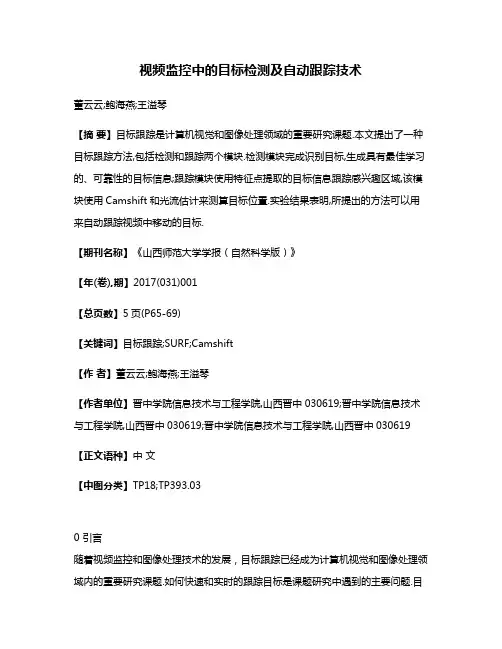
视频监控中的目标检测及自动跟踪技术董云云;鲍海燕;王溢琴【摘要】目标跟踪是计算机视觉和图像处理领域的重要研究课题.本文提出了一种目标跟踪方法,包括检测和跟踪两个模块.检测模块完成识别目标,生成具有最佳学习的、可靠性的目标信息;跟踪模块使用特征点提取的目标信息跟踪感兴趣区域,该模块使用Camshift和光流估计来测算目标位置.实验结果表明,所提出的方法可以用来自动跟踪视频中移动的目标.【期刊名称】《山西师范大学学报(自然科学版)》【年(卷),期】2017(031)001【总页数】5页(P65-69)【关键词】目标跟踪;SURF;Camshift【作者】董云云;鲍海燕;王溢琴【作者单位】晋中学院信息技术与工程学院,山西晋中030619;晋中学院信息技术与工程学院,山西晋中030619;晋中学院信息技术与工程学院,山西晋中030619【正文语种】中文【中图分类】TP18;TP393.030 引言随着视频监控和图像处理技术的发展,目标跟踪已经成为计算机视觉和图像处理领域内的重要研究课题.如何快速和实时的跟踪目标是课题研究中遇到的主要问题.目前各个领域监控数目呈指数式增长,但是大部分监控并没有发挥其应有的作用.如果可以将目标跟踪应用于金融机构的视频监控,就可以有效地防止不法分子的入侵,避免不必要的损失;如果可以将目标跟踪应用于交通监控中,就可以有效地避免交通违法逃逸事件的发生;如果可以将目标跟踪应用于企业生产中,对企业的安全生产也会起到监督指导作用.由于不同领域的安全问题日益突出,因此开发实时的目标检测和跟踪系统至关重要.对监控的视频进行分析的主要步骤有目标检测和目标跟踪.目标检测之前首先进行目标识别,识别该区域中哪些对象为目标.目标检测是定位和分割视频中的感兴趣目标,逐帧地跟踪和分析目标.目前大部分目标检测及跟踪采用背景减除法,它是静态场景中运动目标分割的常用技术.通过减去对时间段内的图像进行平均而创建的当前图像,尝试检测移动目标区域.但是背景减除模型计算复杂,时空开销较大,并且受到较多的延迟,影响实时监视的性能.许多研究者提供了各种应用场景中的目标跟踪算法,包括自动监控、视频索引、人机交互、机器人指导和流量监控等.当前研究目标跟踪算法的使用主要是粒子滤波算法和Camshift算法[1,2].粒子滤波算法可以很好地跟踪物体,但因为其计算复杂,不能满足实时性的要求[3].与粒子滤波算法相比,基于颜色特征的Camshift算法更简单,也可以实现更好的跟踪效果[4].Avidan将支持向量机集成到基于光流的跟踪器中,但是在这样的特征空间下学习分类器计算起来比较复杂[5].本文提出了一种目标跟踪方法,包括检测和跟踪两个模块.目标检测模块使用基于构造的数据库的位置敏感散列快速识别目标,初始化和更新目标的信息以便跟踪它,该模块能够学习目标信息,当目标跟踪失败时基于当前帧重新学习目标信息,重新检测目标.目标跟踪模块通过使用特征点和直方图跟踪目标,在评估目标信息之后重新学习目标信息.1 目标检测及跟踪方法1.1 目标检测对视频监控进行目标检测,首先要进行的是特征提取.目标的每个关键点由某些维向量描述,这些称为特征描述符.一个好的描述符必须具备以下特征:处理亮度变换、旋转变换、尺寸变换、规模变化、照射角度变化.其功能很明显,目标跟踪必须不受尺度缩放和旋转变换的影响,不受视觉点变化的影响,不受照明和遮挡条件的影响,且特征提取的时空开销不应该太大,要满足实时跟踪的要求.通常用于特征提取的方法是目标识别中的SIFT (Scale invariant feature transform ,SIFT)和SURF(Speeded- up robust features,SURF )[6].SIFT旨在解决底层特征提取中的实际应用问题,一般用于图像匹配中.SIFT包括两个阶段:特征提取和描述.描述阶段主要解决特征匹配中的底层特征的应用.SIFT方法中的底层特征提取,根据图像尺度不变、旋转不变、照明条件不变来选择显著性特征.但是SIFT方法随着图像尺寸的增大,因为其高维特征,数据量大量增加,匹配时间较长,因此计算时间也随之增加[7].SURF算法中,使用对Hessian矩阵的行列式来定位特征,Hessian矩阵由理想滤波器构成,它将输入图像与给定尺度的高斯二阶导数进行卷积.SURF使用积分图像概念,积分图是从输入图像快速计算得来的,可以加速任何直立矩形区域的计算.给定输入图像点(x,y),通过点(x,y)和原点之间的值的和来计算积分图像.SURF具有快速特征提取的特性,减少在SIFT方法中特征提取和匹配步骤中操作的复杂性[8],可以减少处理时间,使用特征提取方法和特征描述符得到较好的处理结果.要获取有关初始目标的信息,使用提前学习的数据库.基于SURF提取当前帧中的特征点和描述符,在数据库中高速搜索目标信息,使用位置敏感哈希(locality Sensitive Hashing, LSH)来匹配当前帧的特征信息.1.1.1 SURF(Speeded- up robust features, SURF )SURF通过快速Hessian来自动检测和定位图像中的兴趣点.理论上,兴趣点检测是基于尺度空间理论的,文中的目标检测基于Hessian矩阵,给定图像中的一个点X=(x,y),在点X,尺度为σ的Hessian 矩阵H=(X,σ)定义如下(1)其中,Lxx(X,σ)为图像I中点X处的高斯二阶导数的卷积为图像I中点X处的高斯二阶导数的卷积(X,σ)则表示一阶偏导在x方向上,二阶偏导在y方向上,g(σ)的定义(2)在SURF中,使用箱式滤波器估计二阶高斯导数,并使用积分图像快速评估图像.在原始图像中,通过扩展箱的大小来制定不同尺度的图像金字塔.箱式滤波器是高斯二阶导数的近似值.卷积结果的近似由Dxx、Dxy和Dyy表示,Hessian的行列式Det(H)=Dxx·Dyy-(0.9×Dyy)2(3)不同尺度的图像金字塔,图像被重复平滑以达到更高级别的金字塔.由于使用积分图像和箱式滤波器,不需要对先前的滤波器层的输出运用相同的滤波器.将图像分成八度,每个度包含不同尺寸的图像模板,图像的尺寸s=1.2*N/9,箱式滤波器的尺寸为N*N.1.1.2 位置敏感哈希 (locality Sensitive Hashing,LSH)在N维空间,从海量的点中高效求出距某点最近的点即为NN问题,解决NN问题的一个重要技术是位置敏感哈希(locality Sensitive Hashing, LSH).LSH观点为:原始空间中的两个相邻数据点,点p和点q在同一个桶中连续碰撞的可能性.如果点p和点q彼此接近,那么它们碰撞的可能性就越大;如果p和q之间的距离越远,它们碰撞的概率就较小.对原始的数据经过一系列hash之后,原本相邻的两个数据点变换到了新的数据空间中,它们还是在同一个桶中,相邻的概率还是很大,但是原先不相邻的数据点经过一系列hash之后被映射到同一个桶的概率很小. LSH系列需要满足以下两个条件如果d(q,p)<=d1,概率h(q)=h(p)的概率至少为p1;如果d(q,p)>=d2,概率h(q)=h(p)的概率至少为p2;d(q,p)表示q和p之间的距离,d1<d2, h(q)和h(p)分别表示对q和p进行hash 变换.如果散列函数同时满足上述两个条件,可以称它为(d1,d2,p1,p2)敏感,当通过(d1)敏感性的一个或多个散列函数对数据进行散列时,可以获得一个或者多个哈希表.这个过程称为位置敏感哈希.创建和查询LSH过程为:(1)输入参数;(2) 创建LSH函数;(3) 插入点;(4) 计算每个hash表的hash值;(5) hash值唯一化;(6) hash值相同的归入一类; (7) 计算所有创建的LSH.1.2 目标跟踪目标跟踪方法通常使用MeanShift和CamShift.MeanShift是一种基于外部特征的跟踪算法,利用它可以实现非严格的目标跟踪[9],该算法是一种由直方图定义的跟踪目标的有效方法.CamShift也是目标跟踪的重要算法之一[10],它是计算机视觉中平均偏移算法的改写.MeanShift和CamShift算法的主要区别是:MeanShift是基于静态分布的;CamShift基于连续自适应概率分布.文中目标跟踪模块使用Camshift和光流估计来测算目标位置和目标信息.每个目标的位置,通过目标信息进行评估和确认.目标信息由特征点、描述符、包含目标的窗口、期望目标的位置和其直方图组成.跟踪目标被用于学习目标信息的可信度方面的评估.为了评估目标的可信性,将跟踪的目标信息与标准信息进行比较:最可靠的目标信息定义为级别1,级别1是检测模块中的初始化目标信息.所使用的目标信息主要分为两部分:直方图信息和特征点信息.直方图信息对目标建模是最重要的.使用直方图信息进行以下的工作:(1)定义子窗口;(2)定义和分析目标的形态;(3)标记特征点.定义子窗口:通过将直方图与标准目标直方图进行比较,基于光流的期望目标窗口和CamShift之间选择子窗口.根据直方图的最高速率将每个子窗口划分为正和负子窗口.由包括匹配关键点的正子窗口更新目标的直方图信息.目标的形态定义和分析:分析正直方图和负直方图的分布以定义目标的形状.正子窗口由目标直方图的最大频率定义,可以通过在正子窗口的地图中的负分布来提取目标的形态特征和形状.特征点属于正子窗口,被标记为与正子窗口相同.因此,子窗口包含关于目标的直方图的信息和特征.使用特征点是一种通过匹配特征点来识别目标的简单方法.使用ORB特征点,可以进行以下工作:重新检测目标、预期目标窗口、评估目标的可信性.重新检测目标:当目标跟踪失败时,使用特征点和描述符来检测期望目标窗口,匹配当前训练特征点.期望目标窗口:可以通过使用光流计算单应性来预测目标位置的改变.可信度水平通过确定可信目标的信息来评估.评估可信度水平时,考虑包含正面子窗口的目标信息,目标的形态形状,标签的匹配分布以及基于光流和CamShift的预期窗口.如果决定可信度,则可以通过其他信息来学习提取的目标信息.当目标无法跟踪时,检测模块使用学习目标信息再次检测目标,学习到的目标信息被初始化,具有最高可信度级别的目标信息被更新为标准信息(级别1),再次学习检测到的目标信息.重新检测模块通过匹配子窗口和特征点来识别对象.2 实验及结果实验处理真实的视频监控场景.第一个视频序列如图1所示,是交通视频监控中路况比较简单的视频.第二个视频序列如图2所示,是商务区商场门口的视频监控.将所提方法在视频中进行测试,运行在台式电脑上,处理器为Intel(R) Core(TM)i5- ***************和8 GB的内存,使用opencv实现所提出的对象的检测和自动跟踪.图1 交通监控目标跟踪Fig.1 Object tracking in traffic monitoring图1为交通视频中目标跟踪的部分结果图,从视频出现运动的目标开始跟踪,图1a视频120帧时,检测到路边出现的行人,矩形框出运动的行人;图1b为视频220帧时,黄色的吉普车出现,算法可以检测出现的多个目标,汽车和行人都被检测到(矩形框框出)并且跟踪;图1c为视频320帧,检测到运动的目标(黑色越野车和行人),并且分别跟踪;图1d视频的420帧出现多辆汽车,视频中依然有运动的行人,但是红色和黑色车辆出现遮挡的情况并且运行速度基本一致,检测为同一个运动目标,加上白色车辆和行人,共三个运动的目标.图2为商务区行人目标跟踪的部分程序运行结果.图2a为视频80帧时,此时视频中只有年轻女子一个运动目标,程序检测出运动目标,将目标用矩形框框出来,图2b为视频的110帧时,此时监控画面中进入一对夫妻,但是距离较近,并且运动速度一致,所以将此认为一个运动目标.图2c为视频210帧时的监控画面,年轻女子在170帧离开监控,此后一直到210帧,夫妻离开监控视频;图2d为280帧时,拿手机的男士进入视频画面,其作为新的运动目标对其进行跟踪.由实验结果可以看出,所提方法可以检测并且跟踪运动的目标.但是此跟踪算法不能区分开遮挡、运动速度一致并且距离较近的运动目标.图2 商务区行人目标跟踪Fig.2 Object tracking in business district3 结论视频监控系统需要处理越来越多的数据来识别和跟踪目标.这样的系统需要能够处理大量数据的技术,以便通过提取目标的特征来识别和跟踪目标.因此,为了有效地跟踪视频序列内的移动目标,提出使用先进的特征匹配和Camshift的目标识别和跟踪方法,用于实时环境中的目标跟踪.所提出的算法使用不变的特征来提取目标,减少特征描述符的维度.将所提出的方法用于真实的视频场景中进行实验,结果表明,该方法可以在各种环境中自动地跟踪目标.【相关文献】[1] Bi H, Ma J, Wang F. An improved particle filter algorithm based on ensemble Kalman filter and Markov chain Monte Carlo method[J]. IEEE Journal of Selected Topics in Applied Earth Observations and Remote Sensing, 2015, 8(2): 447~459.[2] Kulkarni M, Wadekar P, Dagale H. Block division based CAMShift algorithm for real- time object tracking using distributed smart cameras[C].//Multimedia (ISM) 2013 IEEE International Symposium on IEEE,2013.292~296.[3] Mei X, Ling H. Robust visual tracking and vehicle classification via sparse representation[J]. IEEE Transactions on Pattern Analysis and MachineIntelligence,2011,33(11):2259~2272.[4] Cong D, Shi P, Zhou D. An improved camshift algorithm based on RGB histogram equalization[C].//Image and Signal Processing (CISP) 2014 7th International Congress on IEEE, 2014.426~430.[5] Avidan S.Ensemble tracking[J].IEEE transactions on pattern analysis and machine intelligence, 2007, 29(2): 261~271.[6] Stommel M.Binarising SIFT- descriptors to reduce the curse of dimensionality in histogram-based object recognition[J]. International Journal of Signal Processing Image Processing and Pattern Recognition,2010,3(1):25~36.[7] Du M, Wang J, Li J, et al.Robot robust object recognition based on fast SURF feature matching[C].//Chinese Automation Congress (CAC) 2013.IEEE,2013.581~586.[8] Wang J, He F, Zhang X, et al. Tracking objects through occlusions using improved Kalman filter[C].//Advanced Computer Control (ICACC) 2010 2nd International Conference on IEEE, 2010,(5):223~228.[9] Leichter I, Lindenbaum M, Rivlin E. Mean shift tracking with multiple reference color histograms[J].Computer Vision and Image Understanding,2010,114(3):400~408.[10] Wang Z, Yang X, Xu Y, et al.CamShift guided particle filter for visual tracking[J].Pattern Recognition Letters, 2009,30(4):407~413.。
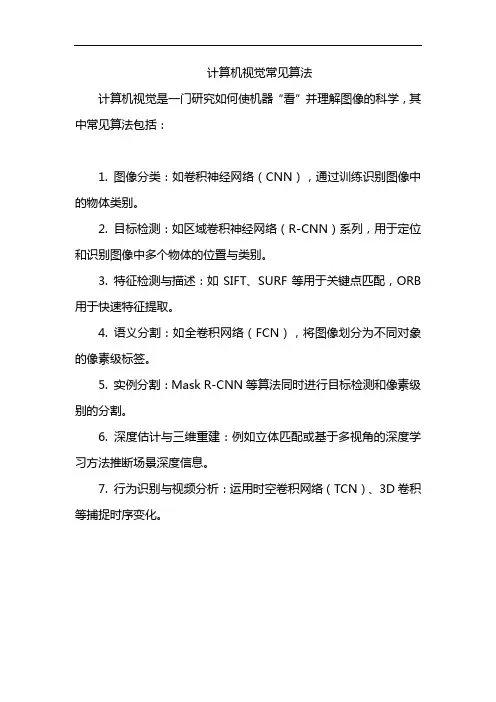
计算机视觉常见算法
计算机视觉是一门研究如何使机器“看”并理解图像的科学,其中常见算法包括:
1. 图像分类:如卷积神经网络(CNN),通过训练识别图像中的物体类别。
2. 目标检测:如区域卷积神经网络(R-CNN)系列,用于定位和识别图像中多个物体的位置与类别。
3. 特征检测与描述:如SIFT、SURF等用于关键点匹配,ORB 用于快速特征提取。
4. 语义分割:如全卷积网络(FCN),将图像划分为不同对象的像素级标签。
5. 实例分割:Mask R-CNN等算法同时进行目标检测和像素级别的分割。
6. 深度估计与三维重建:例如立体匹配或基于多视角的深度学习方法推断场景深度信息。
7. 行为识别与视频分析:运用时空卷积网络(TCN)、3D卷积等捕捉时序变化。
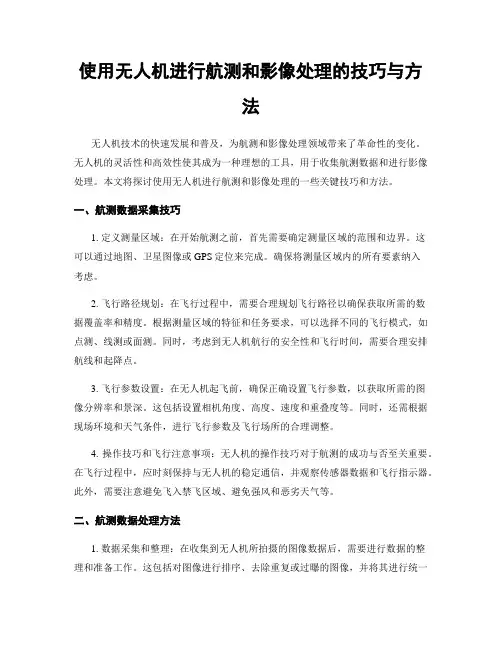
使用无人机进行航测和影像处理的技巧与方法无人机技术的快速发展和普及,为航测和影像处理领域带来了革命性的变化。
无人机的灵活性和高效性使其成为一种理想的工具,用于收集航测数据和进行影像处理。
本文将探讨使用无人机进行航测和影像处理的一些关键技巧和方法。
一、航测数据采集技巧1. 定义测量区域:在开始航测之前,首先需要确定测量区域的范围和边界。
这可以通过地图、卫星图像或GPS定位来完成。
确保将测量区域内的所有要素纳入考虑。
2. 飞行路径规划:在飞行过程中,需要合理规划飞行路径以确保获取所需的数据覆盖率和精度。
根据测量区域的特征和任务要求,可以选择不同的飞行模式,如点测、线测或面测。
同时,考虑到无人机航行的安全性和飞行时间,需要合理安排航线和起降点。
3. 飞行参数设置:在无人机起飞前,确保正确设置飞行参数,以获取所需的图像分辨率和景深。
这包括设置相机角度、高度、速度和重叠度等。
同时,还需根据现场环境和天气条件,进行飞行参数及飞行场所的合理调整。
4. 操作技巧和飞行注意事项:无人机的操作技巧对于航测的成功与否至关重要。
在飞行过程中,应时刻保持与无人机的稳定通信,并观察传感器数据和飞行指示器。
此外,需要注意避免飞入禁飞区域、避免强风和恶劣天气等。
二、航测数据处理方法1. 数据采集和整理:在收集到无人机所拍摄的图像数据后,需要进行数据的整理和准备工作。
这包括对图像进行排序、去除重复或过曝的图像,并将其进行统一标定和校正。
同时,还需将图像与GPS定位数据进行关联,以便后续的数据分析和处理。
2. 数字表面模型(DSM)生成:DSM是航测数据处理中的一项重要任务,用于获取测量区域的地形和高程信息。
根据图像间的重叠度和视差信息,可以使用图像匹配算法来生成3D模型,并通过插值算法,将其转换为连续的DSM。
3. 影像配准和融合:为了获取更准确的航测数据,需要对多个航测图像进行配准和融合。
这可以通过基于特征点匹配的图像配准算法来实现。
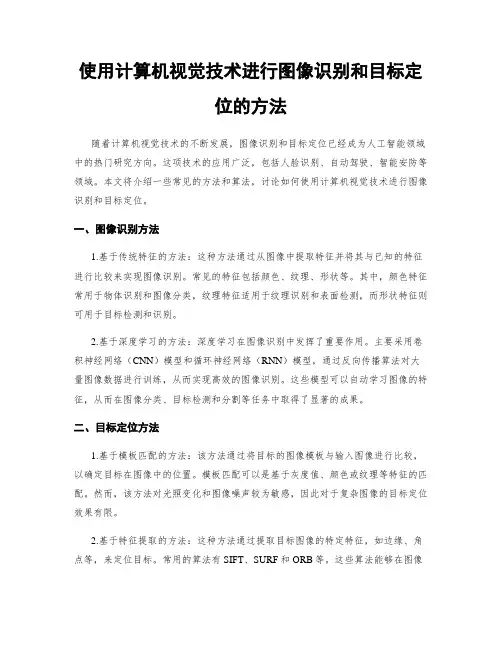
使用计算机视觉技术进行图像识别和目标定位的方法随着计算机视觉技术的不断发展,图像识别和目标定位已经成为人工智能领域中的热门研究方向。
这项技术的应用广泛,包括人脸识别、自动驾驶、智能安防等领域。
本文将介绍一些常见的方法和算法,讨论如何使用计算机视觉技术进行图像识别和目标定位。
一、图像识别方法1.基于传统特征的方法:这种方法通过从图像中提取特征并将其与已知的特征进行比较来实现图像识别。
常见的特征包括颜色、纹理、形状等。
其中,颜色特征常用于物体识别和图像分类,纹理特征适用于纹理识别和表面检测,而形状特征则可用于目标检测和识别。
2.基于深度学习的方法:深度学习在图像识别中发挥了重要作用。
主要采用卷积神经网络(CNN)模型和循环神经网络(RNN)模型,通过反向传播算法对大量图像数据进行训练,从而实现高效的图像识别。
这些模型可以自动学习图像的特征,从而在图像分类、目标检测和分割等任务中取得了显著的成果。
二、目标定位方法1.基于模板匹配的方法:该方法通过将目标的图像模板与输入图像进行比较,以确定目标在图像中的位置。
模板匹配可以是基于灰度值、颜色或纹理等特征的匹配。
然而,该方法对光照变化和图像噪声较为敏感,因此对于复杂图像的目标定位效果有限。
2.基于特征提取的方法:这种方法通过提取目标图像的特定特征,如边缘、角点等,来定位目标。
常用的算法有SIFT、SURF和ORB等。
这些算法能够在图像中找到关键点,并计算它们的描述符,从而实现目标的定位。
特征提取方法的优点是对图像变形和噪声具有较好的鲁棒性,但对于复杂场景和多目标定位较为困难。
3.基于深度学习的方法:深度学习在目标定位中也产生了显著影响。
通过训练一个多层神经网络来学习目标和背景的关系,从而实现目标的准确定位。
这种方法在目标检测和跟踪中使用广泛,可以应对复杂的场景和多目标定位问题。
三、计算机视觉技术的应用1.人脸识别:人脸识别是计算机视觉技术的典型应用之一。
通过识别人脸的特征,如眼睛、鼻子、嘴巴等,可以实现人脸检测、人脸跟踪和人脸认证等功能。

MATLAB中常见的图像识别算法介绍图像识别是指利用计算机视觉技术对图像进行分析和处理,从中提取出有用的信息。
MATLAB作为一种强大的计算软件,提供了丰富的图像处理和分析工具,能够支持各种常见的图像识别算法。
在本文中,我们将介绍几种常用的图像识别算法,并探讨其原理和应用。
一、图像特征提取算法图像识别的第一步是提取图像特征,即从图像中提取出能够代表图像内容的信息。
常用的图像特征提取算法包括SIFT(Scale-Invariant Feature Transform)、SURF(Speeded-Up Robust Features)和HOG(Histogram of Oriented Gradients)等。
SIFT算法通过检测图像中的关键点,并计算这些关键点的描述子,从而表示图像的局部特征。
SURF算法是对SIFT算法的一种改进,它具有更快的运算速度和更好的鲁棒性。
HOG算法则通过统计图像中不同方向上的梯度信息来描述图像的纹理特征。
这些图像特征提取算法在图像识别任务中广泛应用,例如人脸识别、物体检测等。
它们的主要优势在于对图像的旋转、尺度和光照变化具有较好的不变性。
二、图像分类算法在提取了图像特征之后,接下来就是将提取到的特征应用于图像分类任务。
常用的图像分类算法有支持向量机(SVM)、K最近邻(KNN)和深度学习等。
支持向量机是一种经典的机器学习算法,在图像分类中有着广泛的应用。
它通过寻找一个最优的超平面来将不同类别的样本分开。
支持向量机具有较好的泛化能力,能够处理高维特征,对于非线性问题也能够通过核技巧进行处理。
K最近邻算法则是一种简单而有效的分类方法。
它基于样本的邻近性,将测试样本分类为最近邻居中的多数类别。
KNN算法的优势在于对于训练数据没有假设,但存在计算复杂度高和决策边界不平滑等问题。
深度学习是近年来兴起的一种机器学习方法,通过神经网络模型对图像进行表征学习和分类。
深度学习在图像识别领域取得了重大突破,其中卷积神经网络(CNN)是其重要的代表。
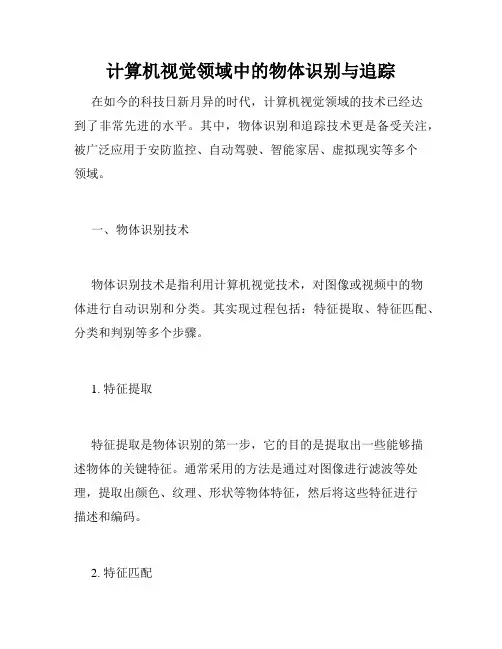
计算机视觉领域中的物体识别与追踪在如今的科技日新月异的时代,计算机视觉领域的技术已经达到了非常先进的水平。
其中,物体识别和追踪技术更是备受关注,被广泛应用于安防监控、自动驾驶、智能家居、虚拟现实等多个领域。
一、物体识别技术物体识别技术是指利用计算机视觉技术,对图像或视频中的物体进行自动识别和分类。
其实现过程包括:特征提取、特征匹配、分类和判别等多个步骤。
1. 特征提取特征提取是物体识别的第一步,它的目的是提取出一些能够描述物体的关键特征。
通常采用的方法是通过对图像进行滤波等处理,提取出颜色、纹理、形状等物体特征,然后将这些特征进行描述和编码。
2. 特征匹配特征匹配是物体识别的核心步骤,它的目的是将提取出的特征点与已知物体的特征进行匹配。
该步骤的主要算法包括 SIFT、SURF、ORB 等。
3. 分类和判别分类和判别是物体识别的最终步骤,它的目的是通过匹配得到的特征,判断图像中的物体是否与已知物体相同。
这一步骤可以采用机器学习算法,如支持向量机、神经网络等。
二、物体追踪技术物体追踪技术是指对视频中的物体进行精确定位,通过不断更新目标位置,实现对目标物体跟踪。
物体追踪技术包括传统基于特征的跟踪方法和基于深度学习的跟踪方法。
1. 基于特征的跟踪方法基于特征的跟踪方法是最早被应用于物体跟踪中的方法。
其核心思想是寻找目标物体中不变的或部分变化的特征点,在下一帧图像中找到这些特征点并进行匹配,从而实现对目标物体的跟踪。
其中最常用的特征点包括 SIFT 特征点、Harris 特征点等。
2. 基于深度学习的跟踪方法近年来,深度学习技术的发展为物体跟踪提供了新的思路。
基于深度学习的方法主要是通过预训练好的卷积神经网络进行特征提取,然后使用支持向量机等分类算法进行分类和跟踪。
三、物体识别与追踪在实际应用中的应用1. 安防监控在安防监控中,物体识别和追踪技术可以应用于人脸识别、车辆识别、行人追踪等方面。
例如,一些高清摄像头可以通过运动目标检测、行人特征提取等技术,实现对犯罪嫌疑人的追踪和识别。
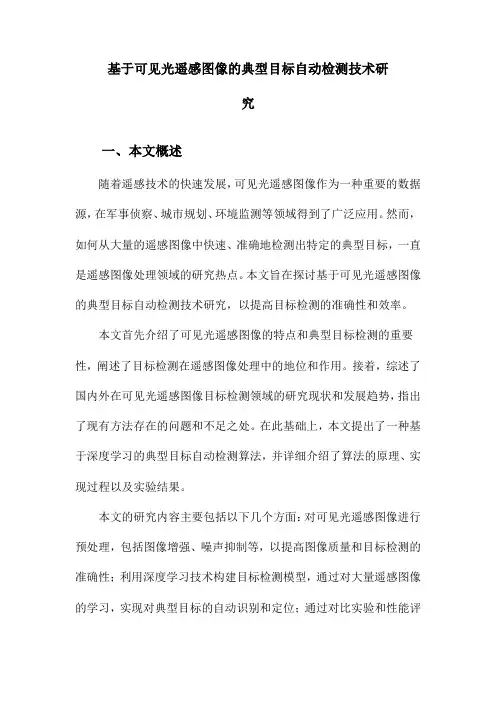
基于可见光遥感图像的典型目标自动检测技术研究一、本文概述随着遥感技术的快速发展,可见光遥感图像作为一种重要的数据源,在军事侦察、城市规划、环境监测等领域得到了广泛应用。
然而,如何从大量的遥感图像中快速、准确地检测出特定的典型目标,一直是遥感图像处理领域的研究热点。
本文旨在探讨基于可见光遥感图像的典型目标自动检测技术研究,以提高目标检测的准确性和效率。
本文首先介绍了可见光遥感图像的特点和典型目标检测的重要性,阐述了目标检测在遥感图像处理中的地位和作用。
接着,综述了国内外在可见光遥感图像目标检测领域的研究现状和发展趋势,指出了现有方法存在的问题和不足之处。
在此基础上,本文提出了一种基于深度学习的典型目标自动检测算法,并详细介绍了算法的原理、实现过程以及实验结果。
本文的研究内容主要包括以下几个方面:对可见光遥感图像进行预处理,包括图像增强、噪声抑制等,以提高图像质量和目标检测的准确性;利用深度学习技术构建目标检测模型,通过对大量遥感图像的学习,实现对典型目标的自动识别和定位;通过对比实验和性能评估,验证了本文所提算法的有效性和优越性。
本文的研究成果对于推动可见光遥感图像目标检测技术的发展具有重要意义,不仅有助于提高目标检测的准确性和效率,还可以为军事侦察、城市规划、环境监测等领域提供有力的技术支持。
本文的研究也为其他领域的图像处理和目标检测提供了有益的参考和借鉴。
二、可见光遥感图像特点与目标检测难点可见光遥感图像,作为一种重要的遥感数据源,具有其独特的特点和优势。
可见光遥感图像具有较高的空间分辨率,能够清晰地呈现出地表目标的形态和结构,有利于目标的精确识别。
可见光遥感图像色彩丰富,可以通过色彩信息来区分不同类型的目标。
然而,这些特点也带来了一些挑战。
在可见光遥感图像中,目标检测面临着一些难点。
由于地表环境的复杂性,目标的形态、大小和颜色都可能发生变化,这给目标的准确识别带来了困难。
可见光遥感图像中常常存在大量的噪声和干扰信息,如云层、阴影等,这些噪声会干扰目标的检测。
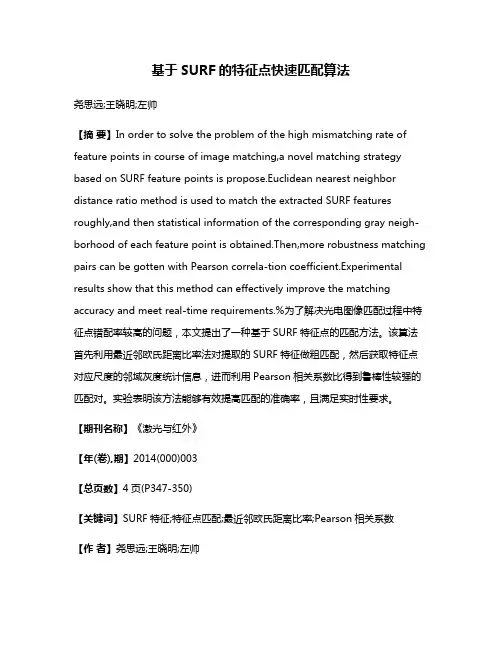
基于SURF的特征点快速匹配算法尧思远;王晓明;左帅【摘要】In order to solve the problem of the high mismatching rate of feature points in course of image matching,a novel matching strategy based on SURF feature points is propose.Euclidean nearest neighbor distance ratio method is used to match the extracted SURF features roughly,and then statistical information of the corresponding gray neigh-borhood of each feature point is obtained.Then,more robustness matching pairs can be gotten with Pearson correla-tion coefficient.Experimental results show that this method can effectively improve the matching accuracy and meet real-time requirements.%为了解决光电图像匹配过程中特征点错配率较高的问题,本文提出了一种基于SURF特征点的匹配方法。
该算法首先利用最近邻欧氏距离比率法对提取的SURF特征做粗匹配,然后获取特征点对应尺度的邻域灰度统计信息,进而利用Pearson相关系数比得到鲁棒性较强的匹配对。
实验表明该方法能够有效提高匹配的准确率,且满足实时性要求。
【期刊名称】《激光与红外》【年(卷),期】2014(000)003【总页数】4页(P347-350)【关键词】SURF特征;特征点匹配;最近邻欧氏距离比率;Pearson相关系数【作者】尧思远;王晓明;左帅【作者单位】华北光电技术研究所,北京 100015;华北光电技术研究所,北京100015;华北光电技术研究所,北京 100015【正文语种】中文【中图分类】TP391.411 引言匹配技术是图像处理中的一项重要内容,它将两幅相似的图像在空间中的位置作对比映射,是后续关键区域分析、相机标定等操作的基础。
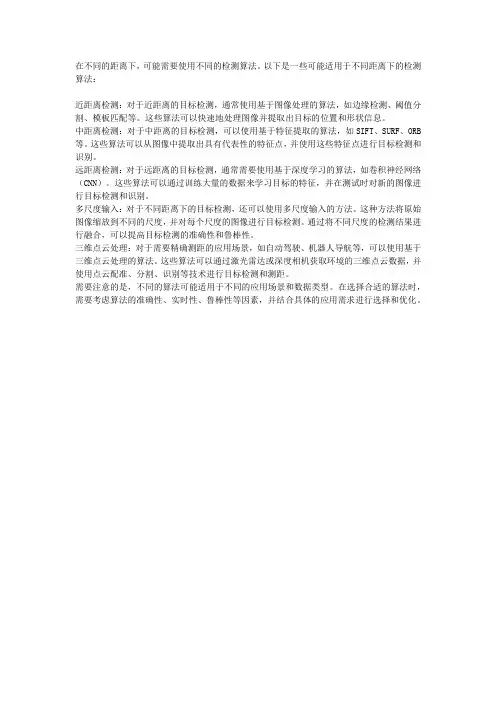
在不同的距离下,可能需要使用不同的检测算法。
以下是一些可能适用于不同距离下的检测算法:
近距离检测:对于近距离的目标检测,通常使用基于图像处理的算法,如边缘检测、阈值分割、模板匹配等。
这些算法可以快速地处理图像并提取出目标的位置和形状信息。
中距离检测:对于中距离的目标检测,可以使用基于特征提取的算法,如SIFT、SURF、ORB 等。
这些算法可以从图像中提取出具有代表性的特征点,并使用这些特征点进行目标检测和识别。
远距离检测:对于远距离的目标检测,通常需要使用基于深度学习的算法,如卷积神经网络(CNN)。
这些算法可以通过训练大量的数据来学习目标的特征,并在测试时对新的图像进行目标检测和识别。
多尺度输入:对于不同距离下的目标检测,还可以使用多尺度输入的方法。
这种方法将原始图像缩放到不同的尺度,并对每个尺度的图像进行目标检测。
通过将不同尺度的检测结果进行融合,可以提高目标检测的准确性和鲁棒性。
三维点云处理:对于需要精确测距的应用场景,如自动驾驶、机器人导航等,可以使用基于三维点云处理的算法。
这些算法可以通过激光雷达或深度相机获取环境的三维点云数据,并使用点云配准、分割、识别等技术进行目标检测和测距。
需要注意的是,不同的算法可能适用于不同的应用场景和数据类型。
在选择合适的算法时,需要考虑算法的准确性、实时性、鲁棒性等因素,并结合具体的应用需求进行选择和优化。
计算机视觉技术的使用中常见问题解决方法计算机视觉技术作为一种涉及图像处理、模式识别和机器学习的领域,广泛应用于人工智能、机器人、无人驾驶等众多领域。
然而,在实际的应用过程中,我们常常会面临一些常见问题。
本文将重点介绍一些常见问题,并提供相应的解决方法。
一、图像质量问题在计算机视觉应用中,图像质量是一个非常重要的因素。
然而,由于各种原因,图像可能出现模糊、噪声、光照不均等问题。
解决这些问题的关键在于采用合适的图像预处理方法。
对于模糊图像,可以使用图像恢复算法进行去模糊处理,例如基于图像模型的盲解卷积算法。
对于含有噪声的图像,可以使用图像去噪算法,如基于小波变换的去噪方法或基于非局部均值滤波的去噪方法。
对于光照不均的图像,可以使用图像增强算法进行光照均衡化,例如直方图均衡化或自适应直方图均衡化。
二、目标检测问题目标检测是计算机视觉中的重要任务之一。
然而,在实际应用中,可能会遇到一些目标检测的困难情况,如遮挡、尺度变化、光照变化等。
解决这些问题的方法之一是采用基于深度学习的目标检测算法,如Faster R-CNN、YOLO和SSD。
这些算法能够通过训练来学习目标的特征表示,从而提高目标检测的性能。
另外,可以采用多尺度目标检测的方法来解决尺度变化的问题。
多尺度目标检测算法会在不同尺度的图像上进行目标检测,从而提高对尺度变化目标的检测能力。
同时,对于光照变化的问题,可以使用光照不变性特征描述子,如SIFT、SURF和ORB等算法,来提高目标检测的鲁棒性。
三、图像配准问题图像配准是指将不同图像之间的特定区域对齐的过程。
在计算机视觉中,图像配准是一个非常重要的任务,例如在医学影像中的注册、多目标跟踪中的对齐等。
然而,由于图像间存在旋转、缩放、平移等变化,图像配准常常面临一些困难。
为解决图像配准问题,可以采用特征点匹配的方法。
特征点匹配是通过提取图像间的特征点,然后通过计算特征描述子的相似性,找到两个图像之间的对应关系。
计算机视觉考试试题及答案1. 图像预处理是计算机视觉中的重要步骤,请简要说明以下预处理方法的作用:a) 图像增强b) 图像滤波c) 图像二值化答案:a) 图像增强:通过改变图像的灰度、对比度等属性,使图像更清晰、更易于分析和识别。
b) 图像滤波:通过去除图像中的噪声、平滑图像等方式,提高图像的质量并减少处理中的干扰。
c) 图像二值化:将图像转化为黑白二值图像,通过阈值处理将像素值分为前景和背景,简化后续的图像处理步骤。
2. 请解释以下计算机视觉中常用的特征描述子及其使用场景:a) SIFT (Scale-Invariant Feature Transform)b) SURF (Speeded Up Robust Features)c) ORB (Oriented FAST and Rotated BRIEF)答案:a) SIFT:SIFT特征描述子通过寻找图像中尺度不变的关键点,并在这些关键点周围计算局部特征描述子,用于图像匹配、目标检测等场景。
b) SURF:SURF特征描述子是一种加速版的SIFT算法,利用快速的特征提取和描述方法,适用于实时性要求较高的计算机视觉应用。
c) ORB:ORB特征描述子结合了FAST关键点检测和BRIEF描述子,并加入了旋转不变性,适用于实时目标识别和跟踪等应用场景。
3. 请简要介绍计算机视觉中的目标检测方法,并说明它们的差异性。
答案:目标检测是计算机视觉中一个重要的任务,常用的目标检测方法包括:a) Haar特征分类器:基于Haar-like特征的级联分类器,通过对图像中不同尺度的矩形区域进行特征计算和分类,具有较快的检测速度。
b) HOG (Histogram of Oriented Gradients):基于图像中梯度方向的统计特征,通过计算图像局部区域的梯度直方图来表示图像,常用于行人检测等场景。
c) CNN (Convolutional Neural Network):基于深度学习的卷积神经网络模型,通过多层卷积和全连接层的组合,实现端到端的目标检测,能够学习更丰富的特征表示。
如何使用计算机视觉技术进行目标跟踪和追踪计算机视觉技术在目标跟踪和追踪领域发挥着重要的作用。
通过计算机视觉技术,我们可以实现对视频、图像中目标的实时跟踪和追踪。
在这篇文章中,我们将讨论如何使用计算机视觉技术来进行目标跟踪和追踪。
首先,让我们了解目标跟踪和追踪的定义。
目标跟踪是指在视频或序列图像中连续追踪一个预定义目标的过程。
而目标追踪是指在视频或序列图像中寻找和确定一个特定目标的位置和姿态。
目标的识别和跟踪对于许多应用来说都是至关重要的,如视频监控、自动驾驶、人机交互等等。
在目标跟踪和追踪中,计算机视觉技术通常包括以下步骤:1. 目标检测:首先,我们需要通过目标检测算法来找到图像或视频帧中的目标。
目标检测算法通常使用图像特征、机器学习和深度学习等方法来实现。
常用的检测算法包括基于特征的方法(如Haar特征、HOG特征)和基于深度学习的方法(如卷积神经网络)。
2. 目标特征提取:一旦目标被检测到,接下来的步骤是对目标进行特征提取。
特征提取可以使用图像处理和特征描述算法,如SIFT、SURF、ORB等。
特征提取的目标是将目标的独特性质转化为计算机能理解和处理的形式。
3. 目标匹配:一旦目标的特征被提取出来,下一步是将当前帧中的目标与之前帧中的目标进行匹配。
目标匹配可以使用各种算法,如相似度度量、相关滤波器和卡尔曼滤波器等。
这些算法可以根据目标的特征和运动信息来估计目标在当前帧中的位置。
4. 目标跟踪和追踪:在目标匹配的基础上,我们可以开始进行目标的跟踪和追踪。
目标跟踪是指在连续的帧中跟踪目标的位置和姿态。
目标追踪则是在视频或序列帧中寻找和确定目标的位置和姿态。
这些任务可以通过目标的运动模型、外观模型和上下文信息等进行。
为了提高目标跟踪和追踪的准确性和鲁棒性,我们可以结合多种计算机视觉技术。
例如,我们可以使用多相机系统来提供更多的视角和更全面的信息。
我们也可以结合深度学习技术,通过大规模的数据训练神经网络来提高目标的检测和跟踪性能。
InteractiveMuseumGuide:FastandRobustRecognitionofMuseumObjects
HerbertBay,BeatFaselandLucVanGoolComputerVisionLaboratory(BIWI),ETHZurichSternwartstr.7,8092Zurich,Switzerland{bay,bfasel,vangool}@vision.ee.ethz.ch
Abstract.Inthispaper,wedescribetheapplicationofthenovelSURF(SpeededUpRobustFeatures)algorithm[1]fortherecognitionofobjectsofart.Forthispurpose,wedevelopedaprototypeofamobileinteractivemuseumguideconsistingofatabletPCthatfeaturesatouchscreenandawebcam.Thisguiderecognisesobjectsinmuseumsbasedonimagestakenbythevisitor.Usingdifferentimagesetsofrealmuseumobjects,wedemonstratethatboththeobjectrecognitionperformanceaswellasthespeedoftheSURFalgorithmsurpassestheresultsobtainedwithSIFT,itsmaincontender.
1IntroductionManymuseumsstillpresenttheirexhibitsinaratherpassiveandnon-engagingway.Thevisitorhastosearchthroughabookletinordertofinddescriptionsabouttheobjectsondisplay.However,lookingforinformationinthiswayisaquitetediousprocedure.Moreover,theinformationfounddoesnotalwaysmeetthevisitor’sspecificinterests.Onepossibilityofmakingexhibitionsmoreat-tractivetothevisitoristoimprovetheinteractionbetweenthevisitorandtheobjectsofinterestbymeansofaguide.Inthispaper,wepresentaninteractivemuseumguidethatisabletoautomaticallyfindandinstantaneouslyretrieveinformationabouttheobjectsofinterestusingastandardtabletPC.Undoubt-edly,technologicaldevelopmentswillleadtolessheavyanddownsizedsolutionsinthenearfuture.Thefocusofthispaperisonthevisioncomponentusedtorecognisetheobjects.
1.1RelatedWorkRecently,severalapproacheshavebeenproposedthatallowvisitorstointer-actviaanautomaticmuseumguide.Kusunokietal.[2]proposedasystemforchildrenthatusesasensingboard,whichcanrapidlyrecognisetypeandloca-tionsofmultipleobjects.Itcreatesanimmersingenvironmentbygivingaudio-visualfeedbacktothechildren.Otherapproachesincluderobotsthatguideusersthroughmuseums[3,4].However,suchrobotsaredifficulttoadapttodifferentenvironments,andtheyarenotappropriateforindividualuse.Aninterestingapproachusinghand-helddevices,likemobilephones,wasproposedby[5],buttheirrecognitiontechniqueseemsnottobeveryrobusttoviewingangleorlightingchanges.Variousobjectrecognitionmethodshavebeeninvestigatedinthelasttwodecades.Morerecently,SIFT[6]anditsvariantssuchasPCA-SIFT[7]andGLOH[8]havebeensuccessfullyappliedformanyimagematchingapplications.Inthispaper,weshowthatthenewSURF(SpeededUpRobustFeatures)al-gorithm[1]surpassesSIFTinbothspeedandrecognitionaccuracy.
1.2InteractiveMuseumGuideTheproposedinteractive,image-basedmuseumguideisinvarianttochangesinlighting,translation,scale,rotationandviewpointvariations.Ourobjectrecogni-tionsystemwasimplementedonaTabletPCusingaconventionalUSBwebcamforimageacquisition,seeFigure1.Thishand-helddeviceallowsthevisitortosimplytakeapictureofanobjectofinterestfromanypositionandisprovided,almostimmediately,withadetaileddescriptionofthelatter.
Fig.1.TabletPCwiththeUSBwebcamfixedonthescreen.Theinterfaceoftheobjectrecognitionsoftwareisoperatedviaatouchscreen.
Anearlyprototypeofthismuseumguidewasshowntothepublicduringthe150yearsanniversarycelebrationoftheFederalInstituteofTechnology(ETH)inZurich,Switzerland[9].Thedescriptionsoftherecognisedobjectsofartarereadtothevisitorsbyasyntheticcomputervoice.Thisenhancestheconvenienceoftheguideasthevisitorscanfocusontheobjectsofinterestinsteadofreadingtheobjectdescriptionsonthescreenoftheguide.Inordertodemonstratetherecognitioncapabilitiesofourlatestimplemen-tation,wecreatedadatabasewithobjectsondisplayintheLandesmuseum.Asampleimageofeachofthe20chosenobjectsisshowninFigure2.
Fig.2.Sampleimagesofthe20chosenartobjectsfromtheLandesmuseum.Theremainderofthispaperisorganisedasfollows.First,weintroduceourobjectrecognitionsystemindetail(Section2).Then,wepresentanddiscussresultsobtainedforamulti-classtask(Section3),andfinallyconcludewithanoveralldiscussionandsomefinalremarks(Section4).
2ObjectRecognitionSystemWedevelopedanobjectrecognitionsystemthatisbasedoninterestpointcorre-spondencesbetweenindividualimagepairs.Inputimages,takenbytheuser,arecomparedtoallmodelimagesinthedatabase.Thisisdonebymatchingtheirrespectiveinterestpoints.Themodelimagewiththehighestnumberofmatcheswithrespecttotheinputimageischosenastheonewhichrepresentstheobjectthevisitorislookingfor.